Benchmarking GeForce GTX Titan 6 GB: Fast, Quiet, Consistent
We've already covered the features of Nvidia's GeForce GTX Titan, the $1,000 GK110-powered beast set to exist alongside GeForce GTX 690. Now it's time to benchmark the board in one-, two-, and three-way SLI. Is it better than four GK104s working together?
Results: Two- And Three-Way SLI Performance
All of our single-card game testing took place on a Windows 8-based test bed. Unfortunately, a number of the three- and four-way SLI tests we ran on GeForce GTX Titan and 690 exhibited lower-than-expected results or crashes. So, we transitioned back to the Geek Box machine supplied for Tuesday’s story, which was already running Windows 7 on a couple of striped SSDs. We’re working with Nvidia to figure out why Windows 8 wasn’t cooperative.
Battlefield 3
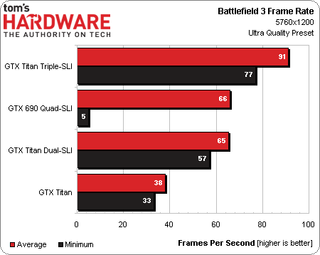
From one to two to three GeForce GTX Titan cards, Battlefield 3 scales nicely. Meanwhile, it’s clear that two GeForce GTX 690s in four-way SLI struggle, dipping to minimum frame rates as low as 5 FPS.

That’s not a one-time occurrence, either. On multiple occasions, Fraps records frame rates that drop under 20. Although the GeForce GTX 690s do well on average, spiking up above 100 FPS even, more consistent performance delivered by two Titan cards yields smoother game play.
Borderlands 2
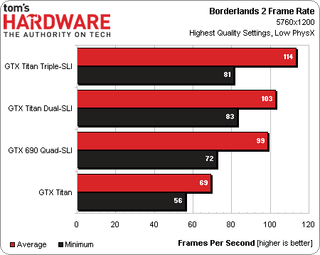
Scaling from one to three GeForce GTX Titans isn’t as clean under Borderlands 2. But the jump to two GK110-based boards is enough to average in excess of 100 FPS. Moreover, two Titans enable a higher minimum frame rate than two GeForce GTX 690s employing four GK104 GPUs.

The Quad-SLI solution doesn’t swing as far up and down in this game as it did under Battlefield 3. However, a quartet of GK104s working cooperatively still appears less consistent than two GeForce GTX Titan boards in two-way SLI.
Stay on the Cutting Edge
Join the experts who read Tom's Hardware for the inside track on enthusiast PC tech news — and have for over 25 years. We'll send breaking news and in-depth reviews of CPUs, GPUs, AI, maker hardware and more straight to your inbox.
There doesn’t seem to be a reason to drop $3,000 on a trio of Titans. If you’re prepared to part ways with $2,000, though, a pair makes more sense than GTX 690s.
Far Cry 3
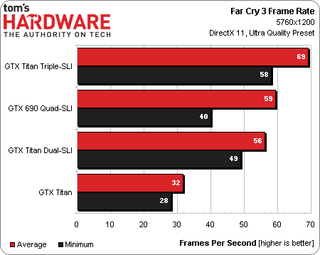
Two GeForce GTX Titans are almost as fast as a pair of GeForce GTX 690s in Quad-SLI on average. But they also achieve a better minimum frame rate. Beyond what the numbers indicate, though, playing this game on four GK104s just feels choppy, as it did on a single GeForce GTX 690 at 2560x1600 and up. Far Cry 3 is a perfect example of why someone interested in a multi-card config should prefer a couple of big, powerful GPUs over four smaller chips spread across two GeForce GTX 690s.
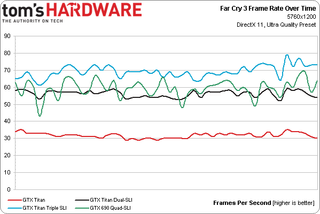
Just look at the even performance of two Titans compared to a pair of GeForce GTX 690s.
Three-way SLI isn't quite as consistent, nor does it yield the substantial jump you see from one card to two. But as a means of kissing 70 FPS, on average, in a very demanding game, a trio of GeForce GTX Titan cards goes unmatched.
Hitman: Absolution
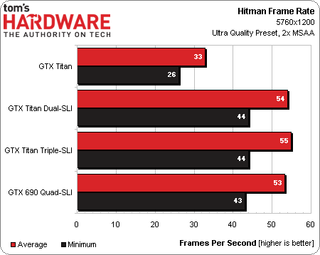
Hitman: Absolution scales reasonably well from one card to two. However, the difference between two or three GK110s and four GK104s is very small in this game's standalone benchmark. We ran our results past Nvidia to confirm what we considered to be suspect findings. Company representatives acknowledged they aren't seeing any scaling from the built-in test, though they do observe higher numbers within the actual game.

The overlapping lines clearly indicate a bottleneck of some sort. It's improbable that the 4.6 GHz hexa-core machine we used for testing limits performance, and given the fact that Nvidia says scaling looks correct in the game itself, we'd be inclined to suspect an issue with the benchmark sequence.
The Elder Scrolls V: Skyrim
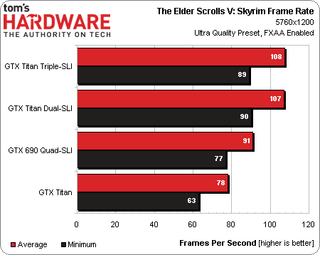
Skyrim started its life severely platform-limited, so we're surprised to see it scaling reasonably well from one to two GeForce GTX Titans. The third GK110-based board is superfluous, though we know there are other titles far more graphics-bound than this one.
The four GK104s you find on a pair of GeForce GTX 690s get outperformed by two Titans. So, again, it's easy for us to point out that Nvidia's latest is best suited to multi-GPU configurations, just as it is ideal in high-performance mini-ITX enclosures.
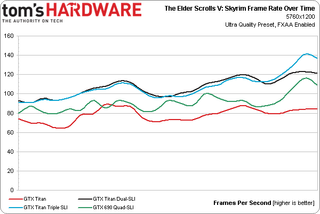
World of Warcraft: Mists of Pandaria
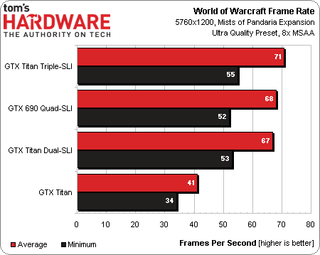
The jump from one GeForce GTX Titan to two yields a modest speed-up in World of Warcraft. However, this is another title not necessarily known for its demanding game engine, so platform-oriented bottlenecks are likely getting in the way of better scaling.
As with Hitman, it'd appear that there is no difference between two and three GK110s, or four GK104s.

Current page: Results: Two- And Three-Way SLI Performance
Prev Page Results: World Of Warcraft: Mists Of Pandaria Next Page GK110 Steps Out: General-Purpose Compute-
Novuake Pure marketing. At that price Nvidia is just pulling a huge stunt... Still an insane card.Reply -
whyso if you use an actual 7970 GE card that is sold on newegg, etc instead of the reference 7970 GE card that AMD gave (that you can't find anywhere) thermals and acoustics are different.Reply -
cknobman Seems like Titan is a flop (at least at $1000 price point).Reply
This card would only be compelling if offered in the ~$700 range.
As for compute? LOL looks like this card being a compute monster goes right out the window. Titan does not really even compete that well with a 7970 costing less than half. -
downhill911 If titan costs no more than 800USD, then really nice card to have since it does not, i call it a fail card, or hype card. Even my GTX 690 make more since and now you can have them for a really good price on ebay.Reply -
spookyman well I am glad I bought the 690GTX.Reply
Titan is nice but not impressive enough to go buy. -
hero1 jimbaladinFor $1000 that card sheath better be made out of platinum.Reply
Tell me about it! I think Nvidia shot itself on the foot with the pricing schim. I want AMD to come out with better drivers than current ones to put the 7970 at least 20% ahead of 680 and take all the sales from the greedy green. Sure it performs way better but that price is insane. I think 700-800 is the sweet spot but again it is rare, powerful beast and very consistent which is hard to find atm. -
raxman "We did bring these issues up with Nvidia, and were told that they all stem from its driver. Fortunately, that means we should see fixes soon." I suspect their fix will be "Use CUDA".Reply
Nvidia has really dropped the ball on OpenCL. They don't support OpenCL 1.2, they make it difficult to find all their OpenCL examples. Their link for OpenCL is not easy to find. However their OpenCL 1.1 driver is quite good for Fermi and for the 680 and 690 despite what people say. But if the Titan has troubles it looks like they will be giving up on the driver now as well or purposely crippling it (I can't imagine they did not think to test some OpenCL benchmarks which every review site uses). Nvidia does not care about OpenCL Nvidia users like myself anymore. I wish there more people influential like Linus Torvalds that told Nvidia where to go.
Most Popular


